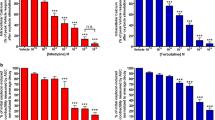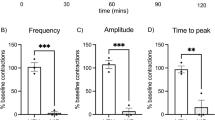Abstract
Progesterone (P4) and nitric oxide (NO) suppress uterine contractility (CTX). This study compares the effects of P4 to sodium nitroprusside (SNP, an NO donor) and their combination on human CTX of term/preterm and labor/nonlabor tissues. Uterine tissues (n = 128) from women (n = 28) undergoing Cesarean were suspended in organ baths. Tissues (n ≥ 6/group) were treated with vehicle, P4, SNP, or combinations. A subset of tissues (n ≥ 2/group) from term/preterm ± labor and nonpregnant patients was analyzed with P4 alone. Analysis of variance (ANOVA) was used for statistical differences (P < .05). The combination of P4 with SNP significantly suppresses CTX (% inhibition of −127.1 ± 14.5) to the levels lower than with either P4 (−20.1 ± 8.6) or SNP alone (−72.0 ± 11.2). Suppression of P4 is similar in term, preterm, and nonpregnant tissues, with increased sensitivity in laboring tissues. This indicates that P4 or SNP alone may be used for preterm labor and their combination may be more successful.
Similar content being viewed by others
References
Csapo A. Force of labor. In: Iffy L, Kaminetzky HA, eds. Principles and Practice of Obstetrics and Perinatology. New York, NY: John Wiley and Sons, Inc; 1981:761–799.
Chwalisz K, Hegele-hartung C, Schulz R, Shi S-Q, Louton PT, Elger, W. Progesterone control of cervical ripening—experimental studies with the progesterone antagonists onapristone, lilopristone and mifepristone. In: Leppert P, Woessner F, eds. The Extracellular Matrix of the Uterus, Cervix and Fetal Membranes: Synthesis, Degradation and Hormonal Regulation. Ithaca, NY: Perinatology Press; 1991:119–131.
Hegele-Hartung C, Chwalisz K, Beier HM, Elger W. Ripening of the uterine cervix of the guinea-pig after treatment with the progesterone antagonist onapristone (Zk-98.299): an electron-microscopic study. Hum Reprod. 1989;4(4):369–377.
Meis PJ, Klebanoff M, Thom E, et al. Prevention of recurrent preterm delivery by 17 alphahydroxyprogesterone caproate. N Engl J Med. 2003;348(24):2379–2385.
da Fonseca EB, Bittar RE, Carvalho MHB, Zugaib M. Prophylactic administration of progesterone by vaginal suppository to reduce the incidence of spontaneous preterm birth in women at increased risk: a randomized placebo-controlled double-blind study. Am J Obstet Gynecol. 2003;188(2):419–424.
Kuon RJ, Shi SQ, Maul H, et al. Pharmacologic actions of progestins to inhibit cervical ripening and prevent delivery depend on their properties, the route of administration, and the vehicle. Am J Obstet Gynecol. 2010;202(5):455.e1–9.
Rouse DJ, Caritis SN, Peaceman AM, et al. A trial of 17 alphahydroxyprogesterone caproate to prevent prematurity in twins. N Engl J Med. 2007;357(5):454–461.
Fonseca EB, Celik E, Parra M, Singh M, Nicolaides KH; Fetal Medicine Foundation Second Trimestar Scrrening Group Progesterone and the risk of preterm birth among women with a short cervix. N Engl J Med. 2007;357(5):462–469.
Gyetvai K, Hannah ME, Hodnett ED, Ohlsson A. Tocolytics for preterm labor: a systematic review. Obstet Gynaecol. 1999; 94(5 pt 2):869–877.
Ruddock NK, Shi SQ, Jain S, et al. Progesterone, but not 17-alphahydroxyprogesterone caproate, inhibits human myometrial contractions. Am J Obstet Gynecol. 2008;199(4):391.e1–7.
Garfield RE, Kannan MS, Daniel EE. Gap junction formation in myometrium—control by estrogens, progesterone, and prostaglandins. Am J Physiol. 1980;238(3):C81–C89.
Garfield RE, Saade G, Buhimschi C, et al. Control and assessment of the uterus and cervix during pregnancy and labour. Hum Reprod Update. 1998;4(5):673–695.
Karteris E, Zervou S, Pang YF, et al. Progesterone signaling in human myometrium through two novel membrane G proteincoupled receptors: potential role in functional progesterone withdrawal at term. Mol Endocrinol. 2006;20(7):1519–1534.
Chanrachakul B, Pipkin FB, Warren AY, Arulkumaran S, Khan RN. Progesterone enhances the tocolytic effect of ritodrine in isolated pregnant human myometrium. Am J Obstet Gynecol. 2005;192(2):458–463.
Gáspár R, Ducza E, Mihályi A, et al. Pregnancy-induced decrease in the relaxant effect of terbutaline in the late-pregnant rat myometrium: role of G-protein activation and progesterone. Reproduction. 2005;130(1):113–122.
Izumi H, Yallampalli C, Garfield RE. Gestational changes in L-arginine-induced relaxation of pregnant rat and human myometrial smooth muscle. Am J Obstet Gynecol. 1993;169(5): 1327–1337.
Yallampalli C, Izumi H, Byam-Smith M, Garfield RE. An L-arginine-nitric oxide-cyclic guanosine monophosphate system exists in the uterus and inhibits contractility during pregnancy. Am J Obstet Gynecol. 1994;170(1 Pt 1):175–185.
Buhimschi I, Yallampalli C, Dong YL, Garfield RE. Involvement of a nitric oxide cyclic guanosine monophosphate pathway in control of human uterine contractility during pregnancy. Am J Obstet Gynecol. 1995;172(5):1577–1584.
Tichenor SD, Malmquist NA, Buxton IL. Dissociation of cGMP accumulation and relaxation in myometrial smooth muscle: effects of S-nitroso-N-acetylpenicillamine and 3-morpholinosyn-donimine. Cell Signal. 2003;15(8):763–772.
Buxton IL, Kaiser RA, Malmquist NA, Tichenor S. NO-induced relaxation of labouring and non-labouring human myometrium is not mediated by cyclic GMP. Br J Pharmacol. 2001;134(1):206–214.
Hoffmann P, Stanke-Labesque F, Fanchin R, Dilaï N, Pons JC, Ayoubi JM. Effects of L-arginine and sodium nitroprusside on the spontaneous contractility of human non-pregnant uterus. Hum Reprod. 2003;18(1):148–151.
Lees CC, Lojacono A, Thompson C, et al. Glyceryl trinitrate and ritodrine in tocolysis: an international multicenter randomized study. GTN Preterm Labour Investigation Group. Obstet Gynecol. 1999;94(3):403–408.
Duckitt K, Thornton S. Nitric oxide donors for the treatment of preterm labour. Cochrane Database Syst Rev. 2002;(3): CD002860. Review.
Buhimschi C, Buhimschi I, Yallampalli C, Chwalisz K, Garfield RE. Contrasting effects of diethylenetriamine-nitric oxide, a spontaneously releasing nitric oxide donor, on pregnant rat uterine contractility in vitro versus in vivo. Am J Obstet Gynecol. 1997;177(3):690–701.
Macdonald PC, Dombroski RA, Casey ML. Recurrent secretion of progesterone in large amounts—an endocrine metabolic disorder unique to young women. Endocr Rev. 1991;12(4):372–401.
Sippell WG, Dorr HG, Becker H, Bidlingmaier F, Mickan H, Holzmann K. Simultaneous determination of 7 unconjugated steroids in maternal venous and umbilical arterial and venous serum in elective and emergency cesarean section at term. Am J Obstet Gynecol. 1979;135(4):530–542.
Dawood MY, Helmkamp F. Human umbilical arterial and venous progesterone concentrations—effect of fetal sex, weight, and mode of delivery. Obstet Gynecol. 1977;50(4):450–453.
Hagemanas FC, Kittinger GW. The influence of fetal sex on the levels of plasma progesterone in the human fetus. J Clin Endocrinol Metab. 1973;36:389.
Fu X, Ulmsten U, Backstrom T. Interaction of sex steroids and oxytocin on term human myometrial contractile activity. in vitro. Obstet Gynecol. 1994;84(2):272–277.
Batra S, Bengtsson B. Effects of diethylstilboestrol and ovarian steroids on the contractile responses and calcium movements in rat uterine smooth muscle. J Physiol. 1978 Mar.;276:329–342.
Kubli-Garfias C, Hoyo-Vadillo C, Lopez-Nieto E, Ponce-Monter H. Inhibition of spontaneous contractions of the rat pregnant uterus by progesterone metabolites. Life Sci. 1990;47(17):1547–1553.
Putnam CD, Brann DW, Kolbeck RC, Mahesh VB. Inhibition of uterine contractility by progesterone and progesterone metabolites: mediation by progesterone and gamma amino butyric acid receptor systems. Biol Reprod. 1991;45(2):266–272.
Perusquia M, Espinoza J, Navarrete E. Nongenomic uterine relaxing effect of RU486 (mifepristone) prior to its antiprogesterone activity in the human pregnancy. Steroids. 2009;74(10–11): 825–831.
Perusquia M. Nongenomic action of steroids in myometrial contractility. Endocrine. 2001;15(1):63–72.
Smith RD, Babiychuk EB, Noble K, Draeger A, Wray S. Increased cholesterol decreases uterine activity: functional effects of cholesterol alteration in pregnant rat myometrium. Am J Physiol Cell Physiol. 2005;288(5):C982–C988.
Anderson L, Martin W, Higgins C, Nelson SM, Norman JE. The effect of progesterone on myometrial contractility, potassium channels, and tocolytic efficacy. Reprod Sci. 2009;16(11):1052–1061. Epub 2009 July 14.
Khorram O, Garthwaite M, Magness RR. Endometrial and myometrial expression of nitric oxide synthase isoforms in pre- and postmenopausal women. J Clin Endocrinol Metab. 1999;84(6): 2226–2232.
Hajagos-Tóth J, Falkay G, Gáspár R. Modification of the effect of nifedipine in the pregnant rat myometrium: the influence of progesterone and terbutaline. Life Sci. 2009 Oct.;85(15–16):568–572. Epub 2009 August 22.
Buhimschi I, Ali M, Jain V, Chwalisz K, Garfield RE. Differential regulation of nitric oxide in the rat uterus and cervix during pregnancy and labour. Hum Reprod. 1996;11(8):1755–1766.
Chwalisz K, Garfield RE. Role of progesterone during pregnancy: models of parturition and preeclampsia. Z Geburtshilfe Perinatol. 1994;198(5–6):170–180. Review.
Author information
Authors and Affiliations
Corresponding author
Rights and permissions
About this article
Cite this article
Orth, T.A., Shi, SQ., Williamson, K. et al. Additive Inhibitory Effects of Progesterone and Sodium Nitroprusside on Uterine Contractility During Pregnancy. Reprod. Sci. 18, 868–875 (2011). https://doi.org/10.1177/1933719111398141
Published:
Issue Date:
DOI: https://doi.org/10.1177/1933719111398141




